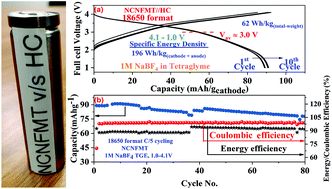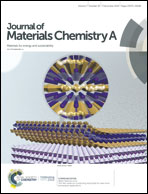Developing an O3 type layered oxide cathode and its application in 18650 commercial type Na-ion batteries†
Abstract
A novel, water-stable and high energy density cathode material Na0.9Cu0.12Ni0.10Fe0.30Mn0.43Ti0.05O2 (NCNFMT) is reported here along with a thorough understanding of structural events during battery operation. Systematic substitutions are carried out, which lead to increase in specific energy densities of this family of cathodes from 274.6 W h kgcathode−1 (NCFM – Na0.9Cu0.22Fe0.30Mn0.48O2) to 304.2 W h kgcathode−1 (NCFMT – Na0.9Cu0.22Fe0.30Mn0.43Ti0.05O2) and finally to 350.7 W h kgcathode−1 (NCNFMT – Na0.9Cu0.12Ni0.10Fe0.30Mn0.43Ti0.05O2). Operando X-ray diffraction reveals phase transformations and ex situ EXAFS shows the evolution of local environments around transition metals during charge/discharge. Monoclinic distortions in the NCFM material during O3–P3 phase transformations are suppressed by Ti4+ substitution leading to improvements in the cycling performance of NCFMT. Cu–O octahedral sites exhibit huge Jahn–Teller distortion: Ni2+ substitution in place of Cu2+ not only leads to more ordered Ni–O, but it also helps extract more Na ions from the O3 cathode structure, thus boosting the capacity while also showing good cycling stability due to the highly reversible bond-length and local environmental changes as revealed by EXAFS analyses. X-ray photoelectron spectroscopy shows a titanium-rich surface for NCFMT and NCNFMT which helps improve water-stability. The capacity retention after 200 cycles at 0.2C is 84%, 96% and 90% for NCFM, NCFMT and NCNFMT respectively. The delivered storage capacities of NCFM, NCFMT and NCNFMT are 21 mA h g−1, 47 mA h g−1 and 60 mA h g−1 respectively at 3C. 18650 type Na-ion batteries using the NCNFMT cathode material against a hard carbon anode are also reported to demonstrate potential scalability of the NCNFMT cathode and efficacy of a 1 M NaBF4 tetraglyme electrolyte system for the first time. 18650 cells deliver a specific energy density of 62 W h kgtotal_18650_weight−1 with 90% energy efficiency, thus being suitable for large scale energy storage applications.



 Please wait while we load your content...
Please wait while we load your content...